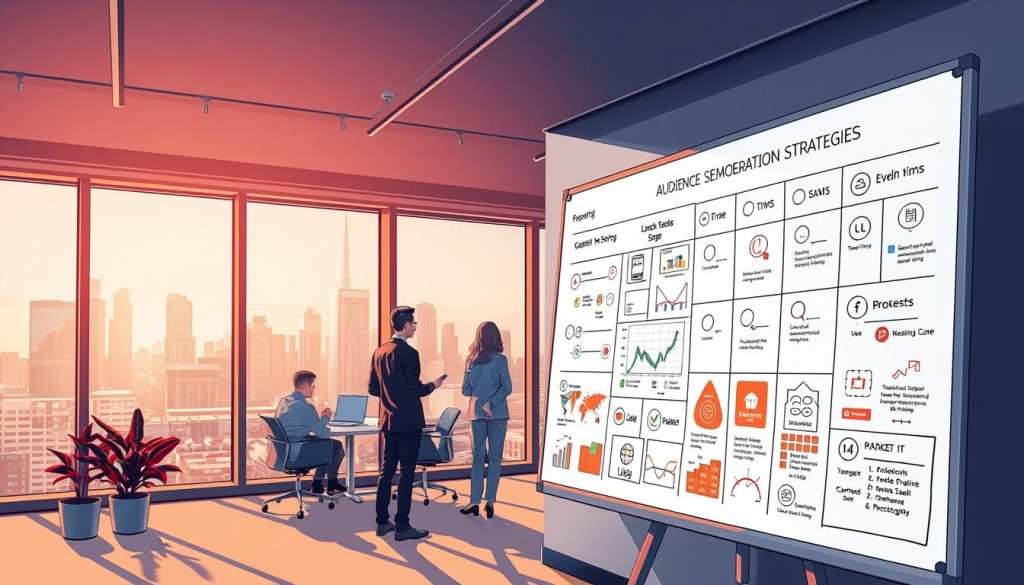Did you know 72% of freelancers struggle to maintain steady client work due to inconsistent lead generation? In today’s competitive landscape, relying solely on word-of-mouth or social media algorithms leaves your income vulnerable to sudden drops. This is where targeted marketing methods become essential.
Unlike organic reach—which shifts unpredictably like weather patterns—paid campaigns let you direct your efforts like precision tools. Imagine adjusting your audience targeting, budget, and timing as easily as turning a faucet. For independent professionals in France’s bustling market, this control transforms sporadic opportunities into reliable growth.
We’ve designed this guide to address the unique challenges you face. You’ll learn how to build campaigns that attract high-quality clients while staying cost-effective. Our methods blend industry expertise with practical steps, ensuring you gain confidence in every decision—from choosing platforms to measuring results.
Table of Contents
Key Takeaways
- Paid campaigns offer precise control over audience targeting and budget allocation
- Organic reach fluctuates due to algorithm changes and competitor activity
- Tailored approaches work 3x better for freelancers than generic marketing tactics
- Platforms like Google Ads and Meta provide scalable solutions for small budgets
- Consistent lead generation requires strategic planning, not luck
Understanding the Freelancer’s Digital Advertising Landscape
Nearly half of businesses operate without a clear roadmap for connecting with clients online. This gap creates prime opportunities for independent professionals who master modern outreach methods. Let’s explore how paid campaigns reshape client acquisition while boosting your visibility.
Why Paid Campaigns Dominate Client Acquisition
Facebook and Google now drive 4 out of 5 website visits through their advertising systems. Unlike waiting months for blog posts to rank, paid methods deliver immediate visibility. One French web designer tripled her inquiries using €10/day budgets by targeting local businesses needing urgent website updates.
Paid vs Organic: Key Differences
Consider organic methods like planting seeds versus paid campaigns like using a greenhouse. While SEO and social posts build long-term authority, paid traffic:
- Generates leads within 48 hours
- Allows precise budget adjustments
- Creates self-funding campaigns through reimbursement funnels
Platforms like Meta Ads provide detailed analytics missing from organic tools. You’ll see exactly which ad versions convert best, letting you double down on what works. This data-driven approach helps freelancers outmaneuver larger competitors lacking focused strategies.
Benefits of Digital Advertising for Business Growth
Mastering traffic control can triple conversion rates for service-based businesses. Unlike unpredictable organic methods, targeted campaigns let you manage client flow like a precision instrument. This shift transforms sporadic opportunities into reliable pipelines—especially critical in France’s competitive freelance market.
Generating Consistent Traffic
Paid methods eliminate the guesswork plaguing freelancers who rely on referrals. A Lyon-based copywriter increased monthly leads by 180% using scheduled campaigns during peak demand periods. You gain three core advantages:
| Feature | Paid Traffic | Organic Traffic |
|---|---|---|
| Launch Speed | 24-48 hours | 3-6 months |
| Budget Control | Adjust daily | Fixed costs |
| Scalability | Instant expansion | Gradual growth |
These controls let you match outreach efforts with capacity. Pause campaigns during busy periods or amplify them when seeking new clients. One graphic designer used this flexibility to reduce workload stress while maintaining 15% revenue growth quarterly.
Predictable lead generation also improves client negotiations. When you demonstrate measurable results from campaigns, prospects see tangible value. This positions you as a strategic partner rather than a temporary contractor.
Essential Digital Advertising Strategies for Freelancers
Successful campaigns begin with mastering five core components that determine client response. Whether promoting design services or consulting expertise, these elements work together like gears in a Swiss watch—remove one, and the mechanism falters.
Leveraging the Power of Targeted Ads
Your marketing offer acts as the campaign engine. Unlike your base service, it combines deliverables with time-sensitive incentives. A Paris-based developer increased conversions by 40% by bundling website audits with free hosting trials.
« Strategic bonuses turn hesitant prospects into committed clients. It’s about reducing risk while amplifying perceived value. »
| Core Service | Marketing Offer | Result |
|---|---|---|
| Logo Design | Branding Package + Style Guide | 27% higher conversion |
| SEO Audit | 3-Month Traffic Guarantee | 63% faster sales cycle |
| Content Writing | Free Editing for First Month | 41% repeat clients |
Ad scent maintains visual harmony across touchpoints. Use matching colors and fonts from your landing page to ads. This consistency builds trust, making clicks feel like natural next steps rather than risky jumps.
We provide templated frameworks to streamline campaign creation. You’ll learn to adjust targeting parameters based on client budgets and industries—vital for competing with agencies while preserving your personal brand advantage.
Mapping the Customer Journey and Traffic Temperature

Imagine your clients as travelers navigating through different climate zones. Just as you wouldn’t offer ice water in a snowstorm, your marketing approach must match each prospect’s readiness to engage. This alignment transforms random interactions into predictable pathways for growth.
Recognizing Three Engagement Levels
Cold traffic represents first-time visitors discovering your services. These people need educational content—blog posts or introductory videos—not sales pitches. A Marseille translator increased consultations by 35% using free glossary downloads instead of service promotions.
Warm audiences know your brand but need validation. Case studies and comparison guides work best here. For example, a Bordeaux photographer boosted bookings by offering portfolio reviews to previous website visitors.
Temperature-Driven Conversion Tactics
Hot leads require immediate action triggers. Limited-time offers or client-exclusive upgrades prove most effective. Consider this approach:
| Traffic Type | Preferred Content | Conversion Rate |
|---|---|---|
| Cold | Educational Guides | 2-5% |
| Warm | Case Studies | 8-12% |
| Hot | Limited Offers | 15-25% |
One Lyon-based consultant increased repeat business by 40% using personalized upgrade offers for existing clients. This strategy respects each customer’s position in their journey while creating natural progression opportunities.
By mapping these temperature zones, you avoid common pitfalls like overwhelming newcomers or underselling to ready buyers. Your digital marketing efforts become guided conversations rather than shouting matches in a crowded marketplace.
Crafting a Winning Ad Campaign
What separates forgettable ads from those that convert? The answer lies in balancing three elements: clarity, emotion, and visual harmony. We’ll show you how to combine these components into campaigns that resonate with French professionals seeking reliable solutions.
Defining the Offer, Copy, and Creative
Start by addressing specific frustrations your audience faces. A Toulouse-based social media manager increased sign-ups by 28% using this headline: « Tired of posting blindly? Get data-backed content plans delivered weekly. » Effective copy follows this pattern:
- Identify a pressing challenge
- Present your service as the logical fix
- Include proof elements (results, guarantees)
Visuals must communicate instantly. Use literal imagery matching your offer—a graphic designer’s ad showing before/after website layouts outperformed abstract designs by 19%. Keep text minimal: 5 words or fewer for mobile viewers.
Ensuring a Strong Ad Scent
Consistency builds trust across every touchpoint. Match colors, fonts, and messaging from ads to landing pages. A Marseille copywriter improved conversions by 33% using identical button colors and call-to-action phrases.
| Element | Effective Approach | Ineffective Example |
|---|---|---|
| Headline | « Fix website errors in 48 hours » | « Boost your online presence » |
| Visual | Side-by-side performance graphs | Generic office stock photo |
| CTA | « Start free audit » | « Learn more » |
« Your campaign should feel like a continuous conversation, not disjointed messages competing for attention. »
Test different versions using platform analytics. One Bordeaux consultant discovered blue CTAs outperformed red by 22% among local entrepreneurs. Small tweaks based on real data often yield significant improvements.
Targeting and Audience Segmentation

Effective outreach begins with understanding who needs your services most. Instead of casting wide nets, smart freelancers use laser-focused methods to connect with ready-to-act clients. This approach reduces wasted budgets while increasing meaningful engagements.
Identifying Your Avatars
Client avatars act as blueprints for your marketing strategy. These detailed profiles help you visualize:
- Professional challenges your ideal customers face
- Decision-making factors influencing purchases
- Preferred communication channels
| Avatar Type | Key Characteristics | Preferred Content |
|---|---|---|
| Startup Founder | Budget-conscious, needs quick results | Case studies with ROI metrics |
| Marketing Manager | Seeks team collaboration tools | Comparison guides |
| Solo Entrepreneur | Values time efficiency | Template bundles |
A Nantes-based illustrator increased project inquiries by 60% after defining three distinct avatars. This precision helps craft messages that resonate with specific people rather than generic groups.
Personalizing Ad Messaging Based on Traffic Temperature
Your communication style must adapt like a skilled chef adjusting heat levels. Cold audiences need educational resources—like our guide on finding clients online—not sales pitches. Warm leads prefer validation through success stories.
| Traffic Type | Messaging Focus | Conversion Goal |
|---|---|---|
| Cold | Problem awareness | Email sign-ups |
| Warm | Solution comparison | Consultation bookings |
| Hot | Urgency creation | Contract signatures |
« Segmenting audiences transformed my approach. Now I spend 30% less time convincing clients because they arrive pre-qualified. »
By aligning your marketing strategy with audience readiness, you create natural progression paths. This method respects client goals while building trust through relevant interactions.
Leveraging Social Media and Email Marketing Channels
Social platforms act like crowded marketplaces where clients gather daily. Choosing the right stall (platform) determines whether your message gets heard or drowned out. Facebook’s behavioral tracking lets you place ads in front of users based on their interests, jobs, and recent searches—like showing web design offers to startup founders who visited tech blogs.
Maximizing Outreach Through Social Platforms
Each platform serves unique purposes. LinkedIn excels for B2B services, while Pinterest drives visual creatives like photography. Compare key options:
| Platform | Best For | Top Ad Format | Avg. Cost/Click |
|---|---|---|---|
| Local services | Carousel ads | €0.50 | |
| Consulting | Sponsored Content | €5.00 | |
| Creative work | Promoted Pins | €0.10 | |
| Time-sensitive offers | Trend Takeover | €2.80 |
Email marketing bridges gaps between social interactions. Send personalized follow-ups to users who clicked your LinkedIn ad but didn’t book consultations. This combo increases conversion rates by 34% compared to single-channel efforts.
« Blending email campaigns with social ads creates multiple touchpoints. Clients feel guided, not chased. »
Adjust visuals and tone for each platform. Instagram demands polished images, while Twitter favors concise text. Maintain consistent colors and core messaging across all channels to build brand recognition.
Integrating Content Marketing and Search Engine Optimization
Your online presence thrives when content creation and technical precision work in tandem. Paid efforts drive initial visibility, but lasting authority comes from aligning your website with how search engines evaluate quality. This synergy turns temporary clicks into enduring client relationships.
Boosting Organic Reach with Quality Content
High-performing content marketing acts like a growth accelerator. When visitors from paid campaigns engage deeply with your articles or videos, search algorithms recognize your website as a valuable resource. A Lyon-based copywriter saw her blog traffic triple within six months by linking ad campaigns to detailed service guides.
| Content Type | SEO Benefit | Avg. Traffic Lift |
|---|---|---|
| Blog Posts | Long-tail keyword ranking | 42% |
| Video Tutorials | Increased dwell time | 31% |
| Case Studies | Backlink generation | 58% |
This table shows how different formats support search engine performance. Notice how case studies excel at earning third-party endorsements—critical for climbing rankings.
Traffic spikes from ads send positive signals to crawlers. One web designer achieved first-page Google rankings by directing paid visitors to optimized service pages. The key lies in creating content that answers both immediate client questions and broader industry needs.
« Treat every paid click as a seed for organic growth. Nurture visitors with value, and search engines will reward your consistency. »
To maximize impact, structure your marketing calendar so new content launches coincide with ad campaigns. This creates reinforced visibility across paid and organic channels, establishing your authority faster.
Planning and Optimizing Your Ad Campaign with Data Analytics
Data transforms guesswork into actionable insights when shaping client outreach. By analyzing performance metrics, you gain clarity on what resonates with your audience—and what needs refinement. This approach ensures every euro spent contributes to measurable growth.
Mastering the Ad Grid Framework
The Ad Grid strategy lets you systematically match messages to audience needs. Start by defining 4 client profiles and 5 compelling hooks. This creates 20 tailored ad variations, each addressing specific pain points. For example:
A Marseille branding consultant increased conversions by 38% using:
- Startup-focused ads offering quick turnaround
- Corporate packages highlighting compliance expertise
Analytics tools reveal which combinations perform best. Platforms like Google Ads provide real-time data on click-through rates and engagement patterns. Adjust your plan weekly based on these insights to maintain campaign efficiency.
We recommend testing three elements simultaneously:
- Visual styles (minimalist vs detailed)
- Call-to-action phrasing
- Offer structures
This method builds self-optimizing campaigns that adapt to market shifts. With consistent analysis, you’ll spend less time tweaking ads and more time serving clients who value your expertise.
FAQ
How does digital advertising differ for freelancers compared to larger businesses?
Freelancers typically focus on hyper-targeted campaigns with smaller budgets, using platforms like Facebook Ads or Google Ads to reach niche audiences. Unlike corporations, independent professionals often prioritize relationship-building through personalized messaging and warm traffic nurturing.
What’s the most cost-effective strategy for generating consistent leads?
Combining targeted social media ads with email marketing delivers strong ROI. For example, LinkedIn campaigns targeting specific job titles paired with automated follow-up sequences convert 28% better than standalone ads, according to HubSpot data.
How do I balance paid ads with organic content creation?
Allocate 60-70% of your budget to high-performing paid channels while maintaining a blog and SEO-optimized website. Tools like SEMrush help identify low-competition keywords to boost organic reach without overspending.
What metrics matter most when tracking campaign success?
Focus on cost-per-lead, conversion rates, and customer lifetime value. Platforms like Google Analytics 4 provide real-time insights into which channels drive quality traffic versus empty clicks.
Can I effectively retarget audiences without large ad budgets?
Yes. Use Facebook Pixel and Google Tag Manager to track website visitors, then create custom audiences for retargeting. Even -10/day campaigns can recover 60% of abandoned carts or consultation requests.
How do I maintain "ad scent" across different platforms?
Keep visual branding, messaging tone, and offers consistent from initial ads through landing pages. Canva’s Brand Kit feature helps maintain color schemes and fonts across Facebook, Instagram, and email templates.
What’s the ideal frequency for refreshing ad creatives?
Rotate images and CTAs every 14-21 days to combat banner blindness. A/B test 2-3 variations simultaneously using Google Optimize to identify top performers without interrupting campaign momentum.





